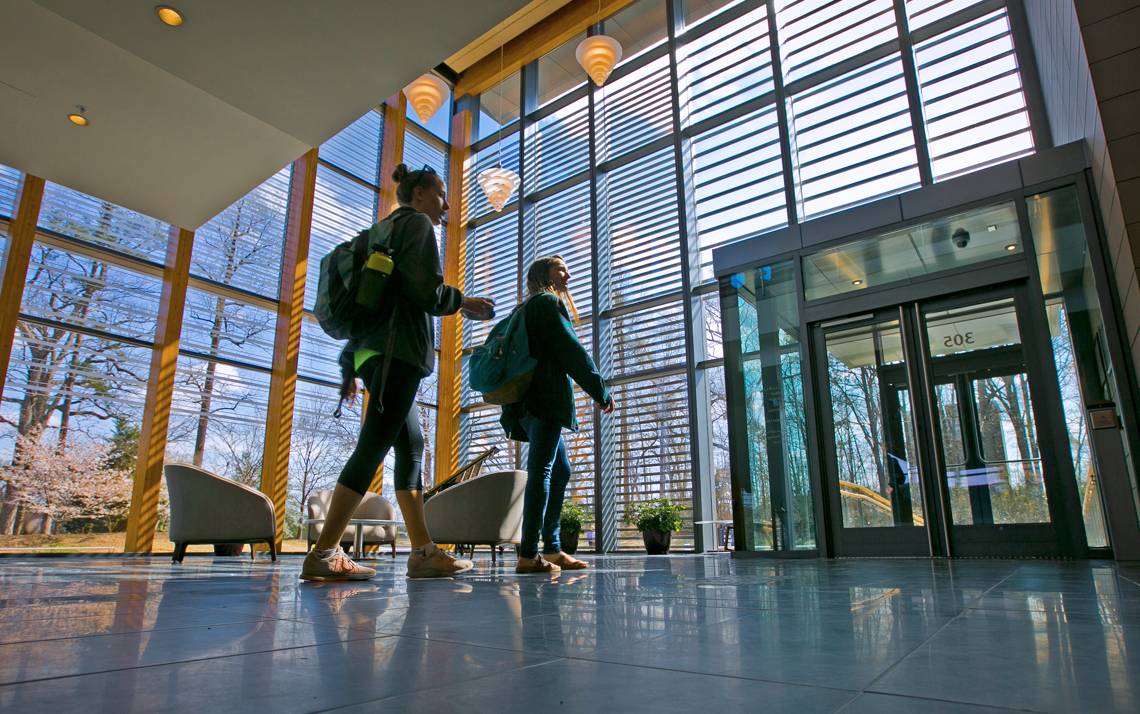A New Plan for Building Green
Duke develops new high performance building standards

A new plan to design more sustainable buildings on campus may be illustrated best by a structure that isn’t a building.
Duke Pond along Towerview Road collects storm water from 22 percent of campus that includes an areas with buildings such as the nearby Student Wellness Center. The center was certified as Silver status in 2018 by Leadership in Energy and Environmental Design (LEED), but it did not receive any points for using reclaimed water on-site. Duke Pond was a more efficient and sustainable approach to capturing storm water from a larger region and directing around 100 million gallons each year to a nearby chiller plant, that provides cooling to campus facilities.
“If we captured water at the building site, it would only be used as gray water for toilets or for local irrigation,” said Duke Facilities Energy Manager Casey Collins. “But by collecting storm water for a larger area at the pond, we get the dual benefit of better water management and greater energy efficiency by feeding the chilled water plant.”
In order to present a more accurate and complete gauge of how Duke University is braiding its need for growth with its mission of sustainability, Duke’s Facilities Management Department has developed its own High Performance Building Framework.
The set of procedures and guidelines creates a standard for new construction and major renovations that moves beyond those set by LEED, which for a quarter century has been the most widely-recognized system for determining just how green a building is.
“LEED was instrumental in helping Duke and many other institutions begin thinking more systemically about sustainable building,” said Duke Vice President for Facilities John Noonan. “But our experience over the years shows that LEED is not well suited to our unique campus-wide, long-term perspective on building development and carbon emissions reduction and that it ultimately leads to a more expensive process on projects that also miss the mark on achieving optimal high-performance energy and water use.”
The new framework, which was unveiled at the Campus Sustainability Committee meeting on March 8 and will be discussed with the Board of Trustees in May, is the result of nearly two years of work by members of the Duke Facilities Management Department and internationally-recognized sustainable design consultant Atelier Ten.
The plan takes a holistic view of green building at Duke by outlining an improved process for planning campus buildings, a rigorous sustainable design standard for all new buildings and major renovations, and a new tracking and rating system to examine how facilities perform. The approach differs from LEED certification, which scores individual buildings based on how many sustainable features they contain.
Duke, which began work on its first green building guidelines in 2001, has been a leader in sustainable building design. And with 44 LEED-certified buildings and four more registered for certification, LEED has helped tell that story.
But as Duke, which aims to be climate neutral by 2024, has made sustainability strides that benefit campus as a whole, it created a need for something more comprehensive than the single-project approach.
“We’re trying to get away from getting a score for a single building and moving toward making better decisions at a higher level and much earlier in the cycle and then pushing forward with some more progressive design standards,” Collins said.
Other universities are also considering similar approaches. Stanford University, home to an award-winning campus sustainability program, also developed its own set of internal standards.
Under Duke’s new proposed building guidelines – which could be in place as early as this fall – new buildings and major renovations will be required to implement up to 46 progressive green building features that address the use of energy and water, take into account the project’s effect on the landscape, consider occupant health and factor in the materials used. These new minimum standards for future projects will supersede the requirements for LEED Silver certification.
And as part of the new framework, Duke will work with an outside consultant to analyze its progress toward these goals.
“We’re trying to make paradigm shift and affect a culture change in how buildings get built,” Collins said. “As a university, we’re not building single buildings, we’re building a campus. This framework offers a system that sets a higher bar and encourages responsible development with a holistic view of campus. It’s the next step in the evolution of green building at Duke.”
Have a story idea or news to share? Share it with Working@Duke.